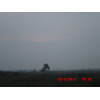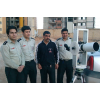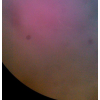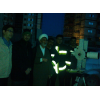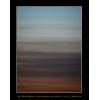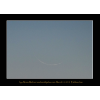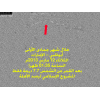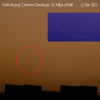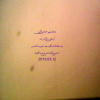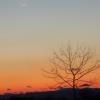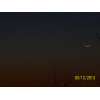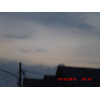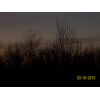Visibility of Jumadal Al-Aula Crescent 1434 AH
- When to Observe Jumadal Al-Aula Waxing (NEW) Crescent ?
- Jumadal Al-Aula Waxing (NEW) Crescent Observation Results
- The OFFICIAL First Day in Different Countries
- When to Observe Rabee' Al-Aakher Waning (OLD) Crescent ?
- Rabee' Al-Aakher Waning (OLD) Crescent Observation Results
When to Observe Jumadal Al-Aula Waxing (NEW) Crescent ?
The geocentric conjunction (Geocentric New Moon) will occur Inshalla on (Monday 11 March 2013) at 19:51 UT.
Sighting the new crescent on (Monday 11 March 2013) and (Tuesday 12 March 2013) is shown in the below graphs using the program Accurate Times by Mohammad Odeh according to Odeh criterion. Where:-
- It is impossible to see the crescent from the areas located under the red color. Because either the Moon on this day sets before the Sunset and/or the topocentric conjunction occurs after the Sunset.
- The crescent is expected to be seen by optical aid only from the areas located under the blue color.
- The crescent is expected to be seen by optical aid from the areas located under the magenta color. In these areas the crescent could be seen by naked eye if the atmospheric conditions are superb and the observer is experienced.
- The crescent is expected to be easily visible by naked eye from the areas located under the green color.
- The crescent cannot be seen from uncolored areas, even though the Moon sets in these locations after the Sunset and the topocentric conjunction occurs before the Sunset, but the Moon is not sufficiently illuminated in order to be seen as crescent even by optical aid.
- Kindly notice that the below graph shows the possibility of seeing the crescent from areas between 60 degrees north of Equator down to 60 degrees south of Equator.
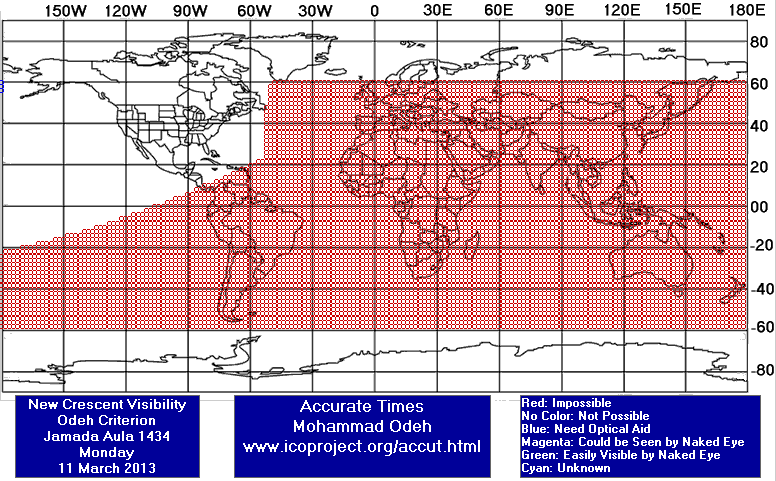
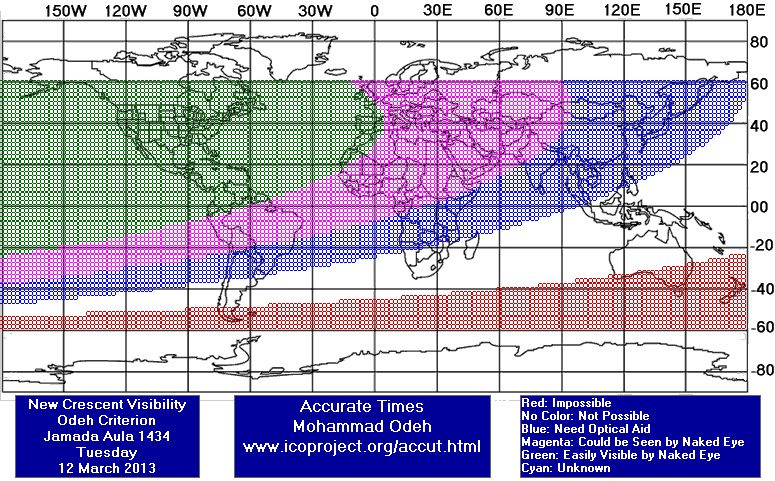
According to the Universal Hejric Calendar (UHC), which is based on the calculated crescent visibility, the start of this month in the Eastern Region will be on Wednesday 13 March 2013 and in the Western Region will be on Wednesday 13 March 2013. Kindly notice that the UHC is a pre-calculated calendar, which adopts a certain criterion to start the new Hejric month. Your country/organization might adopt different criterion to start the new Hejric month. So it is highly advised to read the UHC website before giving any judgment.
- Results of seeing the crescent, and the first day of the month in different countries will be added here Inshalla as we receive the reports from ICOP's members. If you wish to be a member in ICOP, or to know more about it, kindly click here.
Jumadal Al-Aula Waxing (NEW) Crescent Observation Results
Tue 12 March 2013
Algeria
Mr. Hocine Chikh Aissa said: "The new crescent of Jumadal Awwal 1434 was NOT seen by naked eyes and by a binocular,The Sky Near The Western Horizon was Partly Cloudy." "
Indonesia
Mr. AR Sugeng Riyadi said: "The new crescent of Jumadal Ula 1434 AH was NOT SEEN on Tuesday 12 March 2013 rom Assalaam Observatory, Surakarta Central Java Indonesia because rainy."
Iran
Eng. Seyyed Ghasem Rostami said: "First sighting: 17:48 by 5" Telescope Second sighting 18:01 by 9*50 finder "
Mr. Alireza Mehrani said: "New Moon = = = = = = Location: Esfahan, Iran Latitude: 32° 35' 26.59" N Longitude: 51° 38' 11.78" E Elevation: 2070 meters from sea level Time zone: +3.5 Observer & photographer: Alireza Mehrani Date: Tuesday March 12, 2013 (Esfand 22, 1391) Temperature: 16 C° (60.8 F°) Wind: Calm Humidity: 23% Barometer: 843.3 mb Visibility: 10 km Topocentric and local time values from "Moon Calculator" (Refrac off): Crescent first observation through 15x80 binoculars: Time: 18:17LT (14:47 UT) Moon Alt: 6° 45' 42" Sun Alt: - (2° 29' 02") Elongation: 9° 28' 50" Rel Azi: 2° 06' 04" Moon Width: 0.21' Moon Phase: 0.82% Moon Age: 18h 56m after conjunction Crescent first observation through naked eyes: Time: 18:30LT (15:00 UT) Moon Alt: 4° 07' 43" Sun Alt: - (5° 13' 13") Elongation: 9° 34' 34" Rel Azi: 2° 04' 34" Moon Width: 0.22' Moon Phase: 0.84% Moon Age: 19h 09m after conjunction "
Nigeria
Dr. Z.Sani Mustapha said: "The crescent was not sighted by the naked. There were stars although not westwards. According to the sighting of the waning moon on the 27th and 28th day and that Hisab is the backbone of sighting the new moon, since the moon was not sighted on the 28th day and that it was impossible to sight it, the moon appeared today and could be seen by the naked eye. Certainly it was obscured by haze. I do not think one will not regard the sighting of the moon"
Oman
Prof. Mohammed Al-Bussaidi said: "The western horizon was very hazy, and very dusty as such seeing was very bad. However, we managed to image the crescent bybthe aid of a CCD. "
Pakistan
Mr. Alam Sultan said: "Today (Tuesday 12 March 2013 = 29th Rabee'-uth-thani 1434 in Pakistan), we tried but could not sight the moon at nearly 23 places countrywide. Almost bad weather. Announced officially as well that moon was not seen thus Wednesday is 30th Rabee'-uth-thani & Thursday is 1st Juma-dal-oola. "
Saudi Arabia
South Africa
Tunisia
United Arab Emirates
Eng. Mohammad Odeh said: "هذا رصد نهاري للهلال باستخدام السي سي دي كاميرا. ولم ير الهلال باستخدام التلسكوب في النهار. تمت رؤية الهلال في الساعة 01:35 ظهرا، عندما كان القمر على بعد 7.7 درجة من الشمس. تمت الرؤية باستخدام فلتر تحت أحمر ومرة أخرى باستخدام فلتر أحمر ومرة أخرى بدون أي فلتر. لم تغرب الشمس بعد. This is a daytime crescent observation, it was seen by CCD Imaging only. I tried to see it by telescope at daytime but it was not visible. The crescent was seen using IR filter, and another time by Red filter, and another third time without any filter. The Sun didn't set yet."
Eng. Mohammad Odeh said: "This is another observation for the crescent by telescope after sunset, without CCD. It was a challenging crescent! I was about to give up! At the very last moment I was able to see it! It was extremely thin....."
United Kingdom
Eng. Qamar Uddin said: "On Tuesday 12 March 2013 (29 Rabiul Thani 1434 AH) many people from throughout the UK have attempted to sight the crescent moon (Hilal) of Jumada Al-Ula after sunset. None of the groups were able to sight the Hilal, as most places were totally cloudy. However, we have received a reliable sighting report (Muhaqaq-Ruyat-Basari) from the Morocco Awqaf Ministry by fax. Therefore, the Wifaq/Batley Ulama have decided that the month of Rabiul Thani 1434 AH will have 29-days and the month of Jumada Al-Ula 1434 AH will start from Wednesday 13 March 2013, Insha-Allah. "
United States
Dr. Javad Torabinejad said: "I arrived at my sighting location before sunset; the apparent sunset was at 7:22 pm EDT (actual sunset: 7:26 pm). Using a pair of binoculars (7X50), I sighted the crescent at 7:24 pm. It took me 12 more minutes to see the moon with naked eye. The horns were at 3:30 and 8:30 O'clock (3:30;6:00;8:30). The comet PanSTARRS was also visible first by the use of the pair of binoculars at 7:54 pm and then by naked eye at 8:02 pm (Photo 2, upper left corner). I ended the session at 8:30 pm (moonset: 8:37 pm)."
Wed 13 March 2013
Indonesia
Mr. AR Sugeng Riyadi said: "On Wednesday, March 13, 2013 we try again to obeserve the new crescent of Jumadal Ula 1434 AH from Assalaam Observatory, Surakarta Central Java Indonesia. But hilal was not sighted because the west horizon was very hazy."
Malaysia
Tunisia
The OFFICIAL First Day in Different Countries
Tue 12 March 2013
1 . Nigeria
Wed 13 March 2013
1 . Indonesia
2 . Iran
3 . Malaysia
4 . Nigeria
5 . Oman
6 . Saudi Arabia
7 . Tunisia
8 . United Arab Emirates
9 . United Kingdom
Thu 14 March 2013
1 . Pakistan
2 . South Africa
When to Observe Rabee' Al-Aakher Waning (OLD) Crescent ?
The geocentric conjunction (Geocentric New Moon) will occur Inshalla on (Monday 11 March 2013) at 19:51 UT.
Sighting the OLD crescent on (Monday 11 March 2013) and on (Sunday 10 March 2013) is shown in the below graphs using the program Accurate Times by Mohammad Odeh according to Odeh criterion. Where:-
- It is impossible to see the OLD crescent from the areas located under the red color. Because either the Moon on this day rises after the Sunrise and/or the topocentric conjunction occurs before the Sunrise.
- The crescent is expected to be seen by optical aid only from the areas located under the blue color.
- The crescent is expected to be seen by optical aid from the areas located under the magenta color.. In these areas the crescent could be seen by naked eye if the atmospheric conditions are superb and the observer is experienced.
- The crescent is expected to be easily visible by naked eye from the areas located under the green color.
- The crescent cannot be seen from uncolored areas, even though the Moon rises in these locations before the Sunrise and the topocentric conjunction occurs after the Sunrise, but the Moon is not sufficiently illuminated in order to be seen as crescent even by optical aid.
- Kindly notice that the below graph shows the possibility of seeing the crescent from areas between 60 degrees north of Equator down to 60 degrees south of Equator.
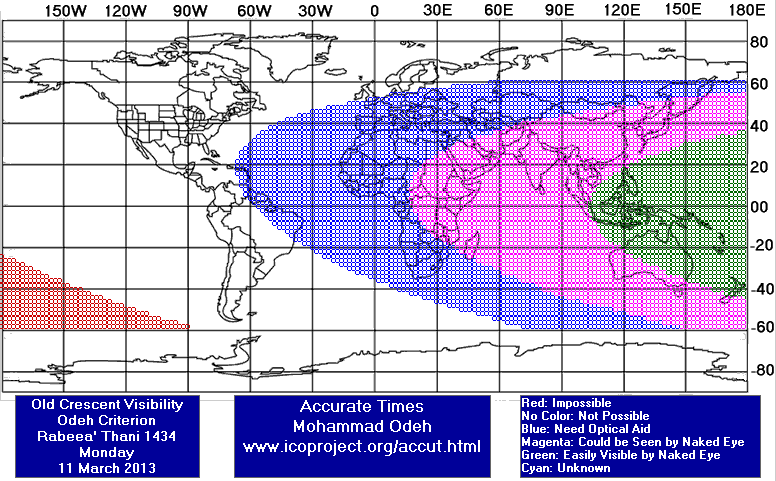
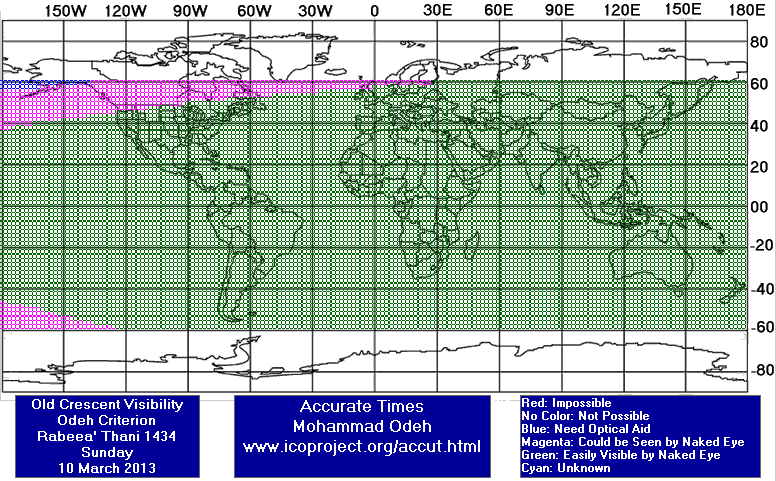
Rabee' Al-Aakher Waning (OLD) Crescent Observation Results
Sun 10 March 2013
Algeria
Indonesia
Mr. AR Sugeng Riyadi said: "The east horizon was very hazy, the old crescent of Rabiul Akhir 1433 AH was NOT SEEN (Sunday, 10 March 2013) from Bendo Ketitang Juwiring Klaten Indonesia."
Nigeria
Dr. Z.Sani Mustapha said: "I was expecting to sight the moon after 5.30am.But due to the hazy atmospheric condition it was sighted at 5.51 am. I stood for 20 minutes. The average variation of sighting the moon from the 18th day was 57 minutes. The western horizon was never clear. If this variation is to be applied for Monday, the moon will be sighted at 6.27. This is not possible for the sun's glow. Therefore according to the Sunna of the holy apostle Rabi'u Thani will be 29 days. There will be no place of contention or not sighting the moon on Tuesday after sun set. If atmospheric conditions that do allow for sighting it, it does not mean that the moon did not appear. Therefore irrespective of physical appearance of the moon on Tuesday, it is only the jesters who will deny its appearance. It is against the sunna then to declare R.Thani 30 days."
United Kingdom
Eng. Qamar Uddin said: "On Sunday 10 March 2013 I tried to look for the waning (old) crescent of Rabi-ul Thani 1434 from the eastern horizon, near the sunrise position, but I was unable to see it as the weather was totally cloudy."
United States
Dr. Javad Torabinejad said: "The eastern horizon was partly cloudy; I waited so long for the moon to appear in between tree branches (actual sunrise: 7:39 am EDT). My first sighting was with a pair of binoculars (7X50). Immediately, I saw the moon with naked eye; the crescent was thin but at that time, I could have spotted it without the use of the pair of binoculars. The horns were at 6:00 and 9:30 O'clock (6:00;8:00;9:30). I stopped the session at 7:51 am."
Mon 11 March 2013
Indonesia
Mr. AR Sugeng Riyadi said: "The east horizon was very hazy, the old crescent of Rabiul Akhir 1433 AH was NOT SEEN (Sunday, 10 March 2013) from Bendo Ketitang Juwiring Klaten Indonesia."
Nigeria
Dr. Z.Sani Mustapha said: "The eastern horizon was much clearer than yesterday. The crescent could not be sighted from 5.41-6.41 am. "
